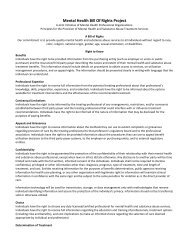2008 Ohio Psychologist - Ohio Psychological Association
2008 Ohio Psychologist - Ohio Psychological Association
2008 Ohio Psychologist - Ohio Psychological Association
Create successful ePaper yourself
Turn your PDF publications into a flip-book with our unique Google optimized e-Paper software.
Consciousness and Meditation: A Zen Experience<br />
Abstract<br />
By: Janette E. McDonald, PhD, Capital University<br />
This article reflects on my three-month sabbatical experience at a Zen Center. While my intentions for such an<br />
experience were many, this paper focuses on only one topic—the potential impact that Zen meditation has on increasing<br />
levels of consciousness and awareness. Through formal sitting meditation, one learns to pay close attention to the<br />
thought processes, which potentially increase one’s mindfulness and levels of personal awareness. One may engage in<br />
meditation whenever one is fully present to the current moment. The following is a phenomenological rendering of<br />
my experience and was collected from personal journal entries, Buddhist literature, and field notes from individual<br />
conversations. I found that quieting the mind in any form, especially sitting meditation, was helpful in developing a<br />
heightened self-awareness and increasing one’s mindfulness.<br />
Introduction<br />
A year ago, I was accepted as a member of a Zen monastery’s<br />
Path of Service program, which allowed me to live and work<br />
in much the same way as the Zen monks. In this paper, I<br />
reflect on the subtle yet important experience of paying<br />
attention through meditation and its benefits. First is a short<br />
explanation of Zen Buddhism and how it connects with<br />
the concept of consciousness, followed by a discussion of<br />
the Zen community (sangha), as interpreted through my<br />
phenomenological lens. I conclude with some repeated<br />
themes of meaning as gathered in dialogue with members of<br />
the monastery.<br />
Zen and Understanding Consciousness<br />
Zen is a form of Buddhism that focuses on sitting meditation,<br />
but it also teaches that meditation can be any form of<br />
concerted attention directed in the present moment. Walking,<br />
gardening, playing musical instruments, preparing meals,<br />
sitting, and cleaning our living quarters were some of the<br />
daily activities performed at the monastery, and all of these<br />
actions could be quite meditative when addressed with<br />
concerted attention.<br />
Some (Suzuki, 2006; Rosenberg, 2004; Kaplau, 2000) have<br />
said that Zen is first and foremost about training the mind<br />
to be centered, conscious, and focused. By sitting quietly,<br />
following the breath, one begins to notice one’s self in ways<br />
never before imagined. When you sit and pay close attention<br />
to your thoughts you notice their speed and scattered<br />
movement as they leap from topic to topic. You see your<br />
negative judgmental side; you feel anger and resentment<br />
that may have been buried for years, and you notice the<br />
tenderness and meaning that human experience offers.<br />
Such clarity can be directed to any action. As you pit a bowl<br />
of cherries, you may experience hundreds of thoughts that<br />
have nothing to do with pitting cherries. Through meditation,<br />
your consciousness is heightened and you begin to notice<br />
different shades of reds, pinks, and purples in each cherry.<br />
You see and appreciate their individual beauty and splendor<br />
in a refreshed way.<br />
Consciousness: A Variety of Definitions<br />
A term called skandhas (or heaps) is well known to Buddhists.<br />
The five skandhas, form, feeling, perception, thought, and<br />
consciousness, make us human and cause our suffering<br />
(Nhat Hanh, 1999). Some words in the Zen tradition, namely<br />
consciousness, mind, and self, have different meanings and<br />
interpretations when compared to how they are understood<br />
in psychology. For instance, some neuroscientists (Hamilton,<br />
2005) have studied consciousness and meditation and argue<br />
that human consciousness is nothing more than brain<br />
functioning. Others maintain that the brain and mind are the<br />
same, and the self is simply a biological bundle of molecules<br />
(Hamilton, 2005). Consciousness viewed in this way does not<br />
and cannot extend beyond the physical body. It is certain to<br />
cease at death.<br />
Consciousness, Karma, and Reincarnation—A Different<br />
Understanding<br />
Buddhists however, view consciousness differently and<br />
understand that the brain and mind are not the same.<br />
Consciousness is viewed as a field of self-awareness, and<br />
for Buddhists, eight levels of consciousness exist. The first<br />
five register the mental association of the sense organs.<br />
The sixth is associated with what might be called mind.<br />
The seventh is known as afflicted consciousness, and the<br />
eighth, alaya, is “the ground basis of all” (Mipham, <strong>2008</strong>).<br />
A detailed discussion of these exceed the purpose of this<br />
paper; however, the Zen sutras suggest this understanding is<br />
thousands of years old and has been passed down through<br />
the great sages.<br />
Furthermore, the Buddhist concept of reincarnation explains<br />
how one’s consciousness may extend beyond one’s current<br />
physical body. The concept of karma helps clarify an<br />
understanding of reincarnation. The laws of cause and effect<br />
are often equated with karma. Simply stated, we will reap the<br />
benefits of this life in our next.<br />
THE OHIO PSYCHOLOGIST AUGUST <strong>2008</strong> 14











